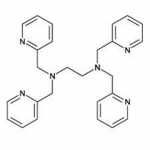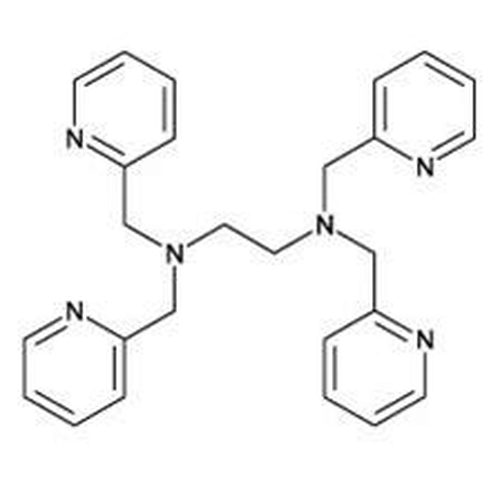| Product Name | TPEN |
| Description |
Heavy metal chelator |
| Purity | >98% |
| CAS No. | 16858-02-9 |
| Molecular Formula | C26H28N6 |
| Molecular Weight | 424.6 |
| Field of Use | Not for use in humans. Not for use in diagnostics or therapeutics. For in vitro research use only. |
Properties
| Storage Temperature | -20ºC |
| Shipping Temperature | Shipped Ambient |
| Product Type | Inducer |
| Solubility | Soluble in DMSO, 100% ethanol or methanol |
| Source | Synthetic |
| Appearance | White to off-white Solid |
| SMILES | C1=CC=NC(=C1)CN(CCN(CC2=CC=CC=N2)CC3=CC=CC=N3)CC4=CC=CC=N4 |
| InChI | InChI=1S/C26H28N6/c1-5-13-27-23(9-1)19-31(20-24-10-2-6-14-28-24)17-18-32(21-25-11-3-7-15-29-25)22-26-12-4-8-16-30-26/h1-16H,17-22H2 |
| InChIKey | CVRXLMUYFMERMJ-UHFFFAOYSA-N |
| Safety Phrases |
Classification: Harmful. May be harmful if inhaled, swallowed or absorbed through skin. Safety Phrases: S22 - Do not breathe dust S24/25 - Avoid contact with skin and eyes S36/37/39 - Wear suitable protective clothing, gloves and eye/face protection S45 - In case of accident or if you feel unwell, seek medical advice immediately (show the label where possible) Risk Phrases: R36/37/38 - Irritating by inhalation, in contact with skin and if swallowed R68 - Possible risk of irreversible effects Hazard Phrases: H315-H319-H335 Precautionary Phrases: P261-P305 + P351 + P338 |
| Cite This Product | TPEN (StressMarq Biosciences Inc., Victoria BC CANADA, Catalog # SIH-231) |
Biological Description
| Alternative Names | N,N,N',N'-Tetrakis(2-pyridinylmethyl)-1,2-ethanediamine |
| Research Areas | Apoptosis, Cancer |
| PubChem ID | 5519 |
| Scientific Background | TPEN is a high-affinity chelator of transition metals such as zinc and iron. In neuroscience, TPEN is used to investigate the role of metal ions in oxidative stress, synaptic signaling, and neurotoxicity. Its ability to modulate intracellular metal levels makes it a valuable agent for studying metal dyshomeostasis in neurodegenerative disorders like Alzheimer's and Parkinson's disease. |
| References | 1. Kim J.H., Kim J., Park Y.H. Cheun K.J. and Jang Y.H. (2010) Korean J Anesthesiol. 58(3): 290-295. |



Reviews
There are no reviews yet.